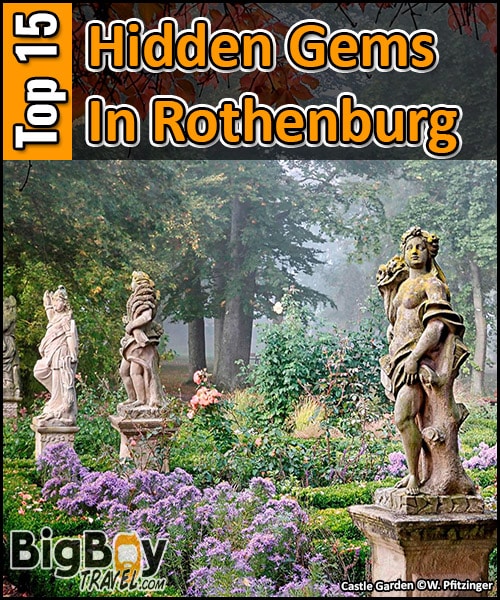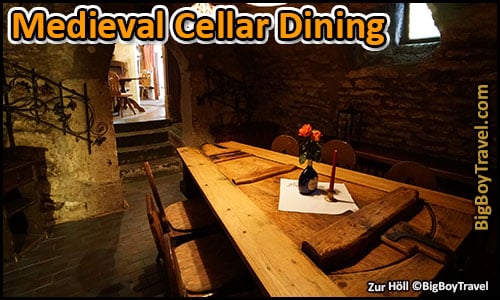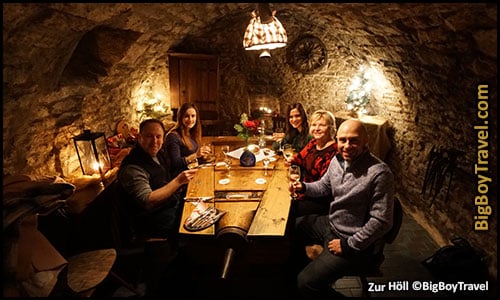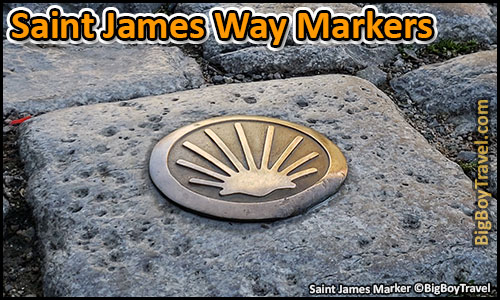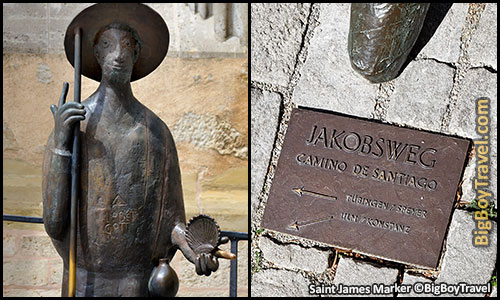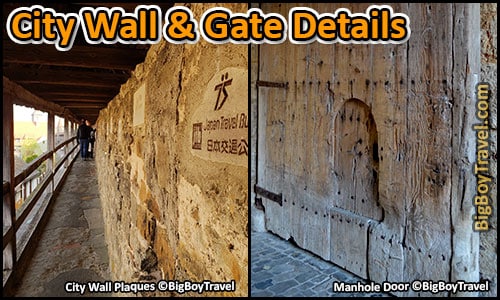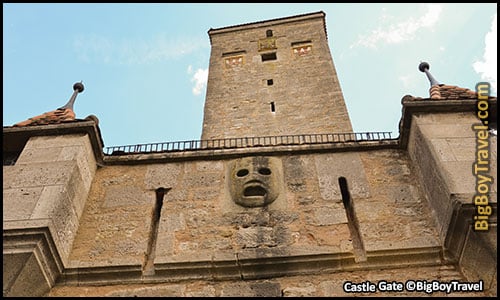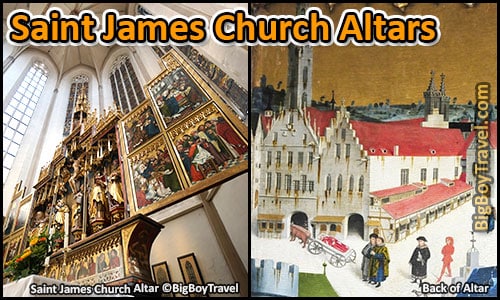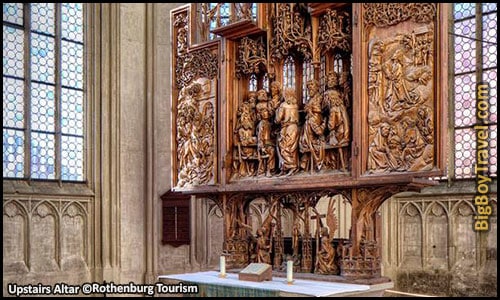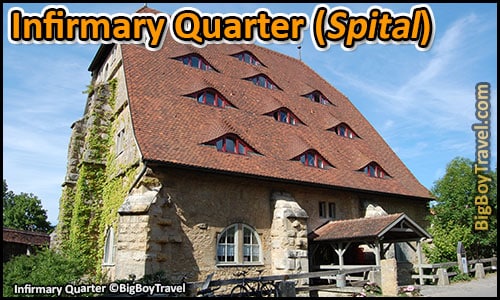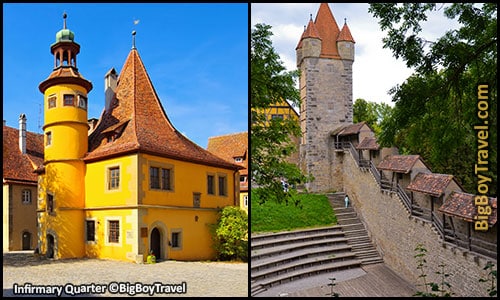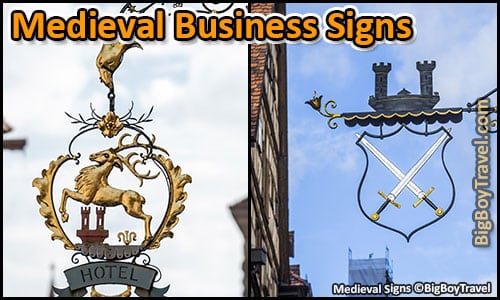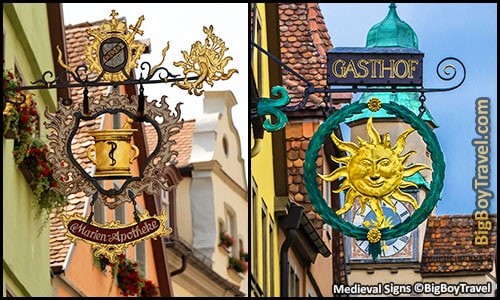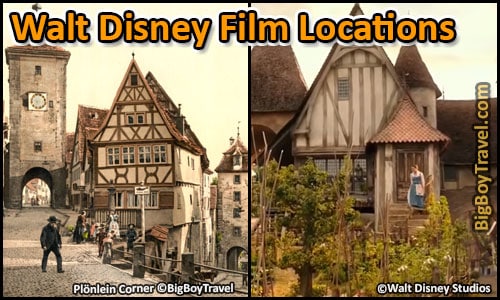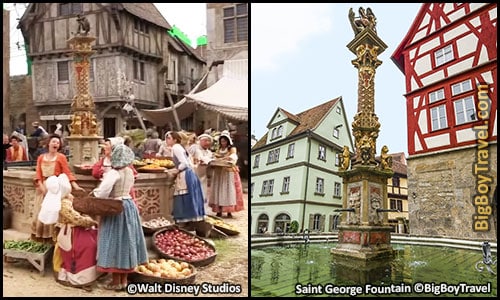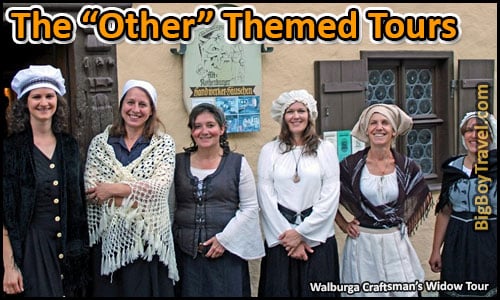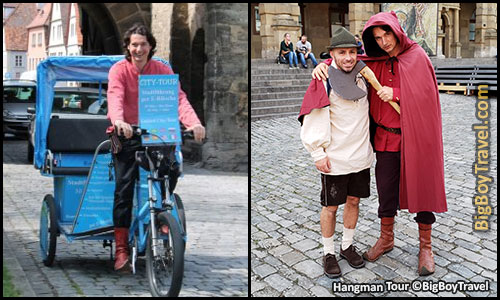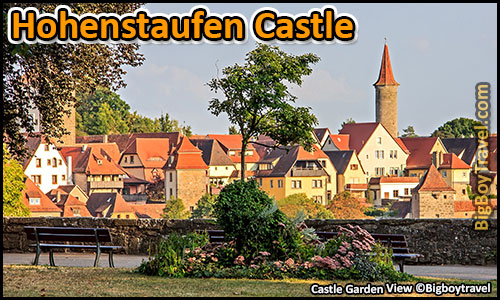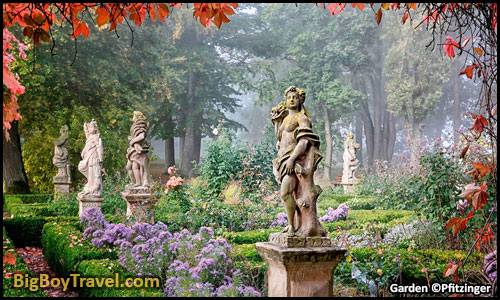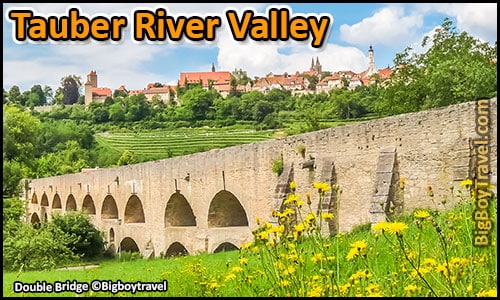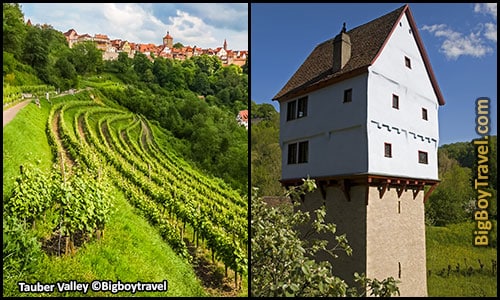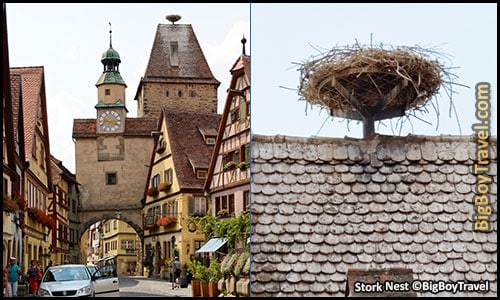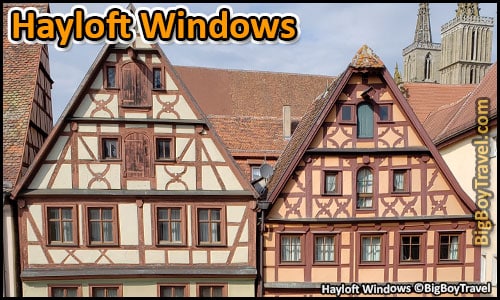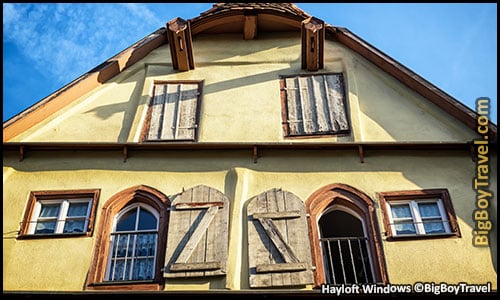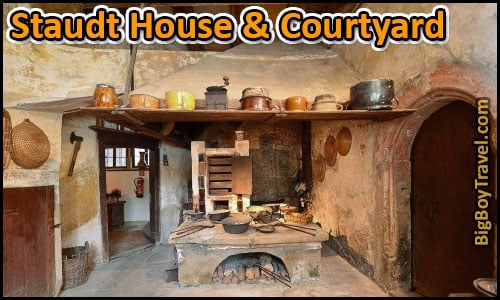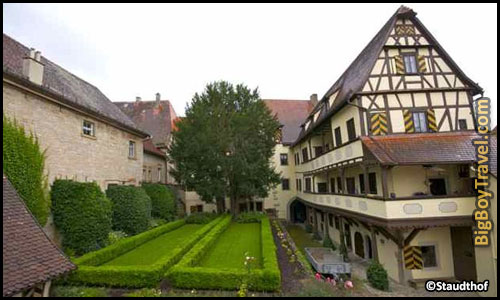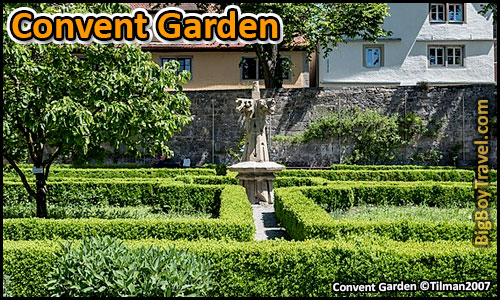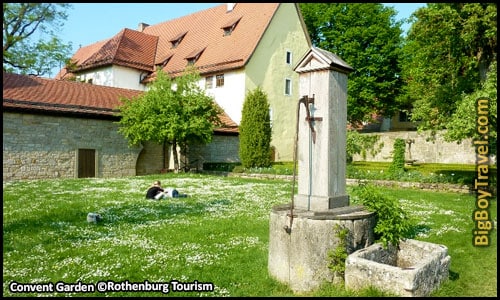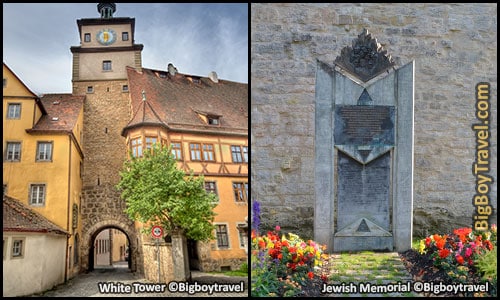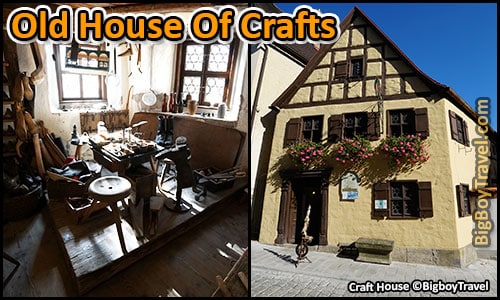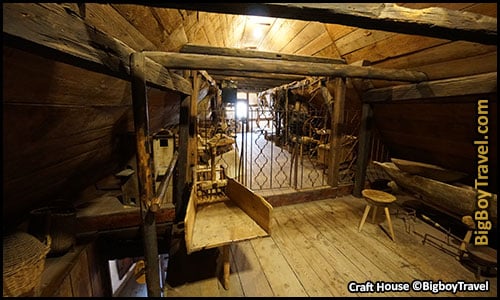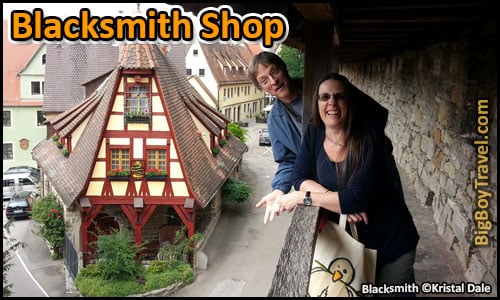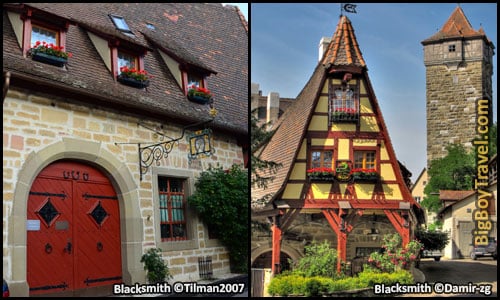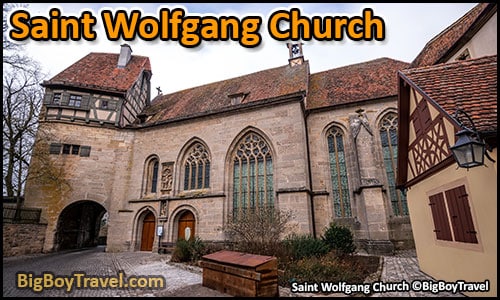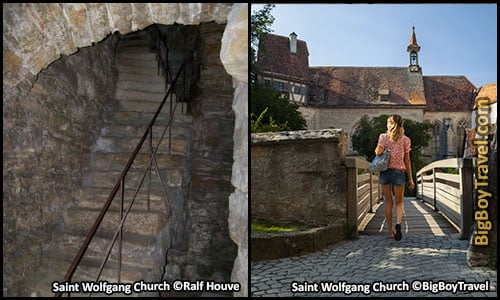Top 15 Hidden Gems In Rothenburg:
Every time we visit the magical village of Rothenburg, it seems that we uncover brand new hidden gems that were hiding in plain sight. Some of the gems we’ve found in Rothenburg took some exploring to find, many we didn’t appreciate until we knew their hidden meaning, and others were right out in the open but were initially overshadowed by other amazing things around them.
We’ve compiled our list of the top 15 hidden gems in Rothenburg below which you can seek out like a Medieval scavenger hunt during your visit. Hope you enjoy it!
Related Article: Top 10 Things To Do In Rothenburg
Top 15 Hidden Gems In Rothenburg:
1. Medieval Cellar Dining:
About Rothenburg’s Medieval Cellar Dining: With a delicious combo of Franconian and Bavarian cuisines in a village essentially frozen in time in the year 1631, you have a lot of unique dining options in Rothenburg. There are a dozen restaurants that we could easily recommend in town, but two of them share a common hidden feature different from the rest: Medieval cellar dining.
The first of these restaurants is To Hell Tavern (Zur Höll, website) which is not only our favorite place to eat in Rothenburg, but is also located in the oldest house in town. Hidden in the back of the restaurant is the original Medieval cellar with a foundation dating back to 970AD. You have to make reservations well in advance for this private dining area but it is a once-in-a-lifetime experience. The cave-like cellar is not only romantic but also has historic details incorporated in it. The best is the 8-foot-long kiln blower which now serves as the table, but was once used by a blacksmith in late-Medieval times when the cellar was a forge.
Rothenburg also has a second Medieval cellar to eat in hidden below the Ratsstube (website) in the middle of Market Square. We had eaten here 3 times before learning there is hidden dining in the cellar and it is definitely where you want to sit. The famous restaurant is where King Christian I of Denmark ate during his stay in town 1474. The history and the setting really make these Medieval cellars the best hidden gems of Rothenburg. Other restaurants we love near include the Imperial Kitchen Master Restaurant (Reichs Küchenmeister, website) and The Master Builder’s House (Baumeisterhaus, website).
Related Video: Tour Of Zur Höll Restaurant
2. Saint James Way Markers (Jakobsweg):
About The Saint James Way Markers: As you walk the streets of Rothenburg you are going to see numerous seashell medallions in the cobblestone pavement and wonder what they are for. These hidden gems mark the routes for the 5 segments of the Saint James Way which converged in Rothenburg and helped the early city to prosper. These pilgrimage routes spiderwebbed around Europe in Medieval times carrying travelers all the way to the shrine for the Apostle Saint James on the coast of northwestern Spain. Saint James had been martyred by beheading in Jerusalem in 44AD and gained the symbol of the seashell because the coast in Spain where his shrine is located has a lot of shells.
Knowing the hidden meaning behind these seashell markers, which also resemble rays of sunlight, makes your visit to Rothenburg a lot more fun. As you follow the shells around town you are lead to the massive Saint James Church built in the saint’s honor. It was here where the Saint Jacobs Trails from Prague to Speyer met the route from Wurzburg to Ulm/Konstanz before both eventually meet the Camino De Santiago in Spain. For around 400 years from 1200-1600, this was one of the main pilgrimage centers in all of Germany, and rubbing the staff of shell held by the statue of Saint James at the church are said to bring travelers good luck.
3. City Wall & Gate Details:
About The City Wall & Gate Details: The marvelous Medieval city wall that surrounds Rothenburg is one of the attractions to experience, but it too has a number of hidden features you don’t want to overlook. The things that are most commonly missed are the details hidden in the Medieval gates of the village. It can be easy to pass through the different gates dozens of times before you notice them, but we are here to help.
On the Western gate facing the former grounds of Hohenstaufen Castle is the might Castle Gate which itself has 3 hidden gems. The first is the special Eye-of-the-Needle door with a small opening only big enough for one person without armor at a time, known as the manhole. This small door carved in 1555 was the only way into town if you missed curfew at dark when the gates were locked. In the middle of this gate is the decorative Pitch Nose Mask (pechnase) where hot oil or tar would pour out on attackers. On the sides of the mask, you’ll see two large slots where chains were fastened to raise the gate’s drawbridge. Make sure to go around to the side of the gate for the third hidden gem which is the unique perspective you get from the profile view that makes the former drawbridge more clear.
On the far Southern end of the Rothenburg is the figure-eight-shaped Spital Gate with its own hidden gem. The Latin inscription over the outside of the gate says “Peace to those who enter; Farewell to those who leave” which has become the mission statement of Haneda Airport in Japan.
The Woodsman Tower Gate (Röderturm) on the Eastside of Rothenburextremely extremely popular, but many people don’t know that on the weekends you can climb all the way to the top of it for amazing views of the wall. It was here where the Nightwatchmen would signal back to town that all was well each evening. Near this tower is also where you can find stone plaques inside the wall with family names on them. These are the names of the people from all over the world who have donated money to sponsor part of the wall to help with restorations needed after damage from World War 2.
Related Article: Rothenburg City Wall Walking Tour.
4. Altars At Saint James Church:
About The Altar At Saint James Church: Tourists flock into the stunning Saint James Church in Rothenburg, only to miss one of the most important things to see, the backside of the main High Altar. Sitting at the end of the nave, the High Altar was dedicated to the 12 Apostles when it was completed in 1446. How you see it from the front is open, and the side panel wings would actually fold in like doors in Medieval times outside of church service times. While the carved frontside (inside) is a focal point of the church, the backside (outside) of the altar is a true hidden gem of Rothenburg. Brilliantly painted by Friedrich Herlin the back has the oldest known representation of Rothenburg which predates when half of the current Town Hall was rebuilt in 1572. The stained glass windows from 1350 really help to light up the backside of the High Altar so don’t miss it.
The backside of the High Altar isn’t the only hidden gem inside Saint James Church. The famous woodworker Tilman Riemenschneider has multiple carved altars from 1490-1520 also on the lower level of the church which gets confused for his more famous work which is more hidden. For the real treat from Riemenschneider, you have to go up the stairs at the back of the church for his priceless masterpiece behind the organ. Carved from 1499-1505 out of limewood the Altar of the Holy Blood, also called the Franciscan Altar, is one of the best late-Gothic works in Germany. The two-story-tall has 3 carved panels including The Last Supper sitting under the Relic of the Holy Blood which is a crystal said to hold a drop of Jesus’s blood that was set into a wooden cross in 1270. This is the only Protestant church to hold a Roman-Catholic relic as the church changed affiliation in 1544 after the Reformation but the relic was allowed to stay.
5. Infirmary Quarter:
About Infirmary Quarter: While you are bound to have visited Infirmary Quarter if you have been to Rothenburg more than once, the first-time tourist is likely to miss out on this hidden gem. Resembling an appendix sticking out of the Southern end of town, the Infirmary Quarter is home to some delightful buildings and amazing views of the Tauber Valley. This area of Rothenburg was left outside the original city walls and was mainly developed as a hospital by the Knights of the Hinterland. It Infirmary was finally enclosed by a wall in 1370 and after a fire in the 1500s, many of the delightful buildings you see today were built out of the ashes.
It is both the collection of unique buildings from the 1500s and the overall tourist-free peacefulness that make the Infirmary Quarter a hidden gem of Rothenburg. The bright yellow former hospital kitchen known as the Hegereiter House looks so cozy it could be in a Disney movie. The Old Horse Mill (Rossmühle), which is now a youth guest hostel, has ten rooftop windows that peek out at you like playful blinking eyelids. The figure-eight-shaped Hospital Bastion (Spitalturm) defense system is also tons of fun with a covered bridge, cannons, and a dry moat for you to explore.
Our favorite area of the Infirmary Quarter is the Toppler Amphitheater next to the Little Flushing Tower (Stöberleinsturm). This open-air theater sits in a natural bowl and butts up against a unique section of the Medival wall which is made up of roof sections with staggered heights. The Little Flushing Tower overlooking the Amphitheater looks like something straight out of a fairytale book. It is near this tower that the Counts of Komburg built a small fort in 1080 called “Vinegar Jug” which pre-dates the village of Rothenburg. Conrad Hohenstaufen married the daughter of the last of these counts and established his castle (ruined in the Earthquake of 1356) in today’s Castle Garden before becoming the King of Germany which helped to establish Rothenburg.
6. Medieval Business Signs:
About The Medieval Business: You may have noticed decorative iron signs hanging over businesses in places like Salzburg before, but in Rothenburg, this practice is taken to an extreme level with almost every property having its own unique signage. These expressive signs were meant to serves as symbols for either the name of the house or as a representation of the type of business because in Medieval times most people couldn’t read. From the Iron Hat Hotel to Mary’s Pharmacy, the Golden Greifen, and the Golden Sun, there are dozens of amazing medieval signs on every street in Rothenburg.
Some structures around town even have the black Imperial Eagle from Rothenburg’s time in the Holy Roman Empire or the Red Castle (Rothenburg) icon which is the official crest of the village. Knowing the hidden meaning and origin of the Medieval signs makes it a lot more fun to keep track of all the different ones you find.
7. Walt Disney Movie Locations:
About The Walt Disney Locations: Even some of the most popular spots in Rothenburg have hidden secrets to learn about as many locations in town have been featured in Disney movies. The preserved picturesque village is like a real-life fairytale so we aren’t surprised that Walt Disney was so inspired. Many of the half-timbered houses and cobblestones lanes were used to create Pinocchio’s village in the 1940 Disney animated version of Pinocchio! The most predominant locations you will recognize in various forms during Pinocchio are Plönlein Corner, Mark’s Tower Gate, and outside of the White Tower (WeißerTurm).
In more modern times Rothenburg came back into the spotlight with the 2017 live-action version of Disney’s Beauty and the Beast. Plönlein Corner was once again featured as the inspiration for Belle’s home which was painted in the style of Conques, France instead of its normal bright yellow. On the movie set in London, they also re-created a life-sized version of Rothenburg’s Saint George Fountain from Market Square to serve as the central fountain for the fictional village in the film. This fountain was also partially reproduced along with a representation of Rothenburg’s Town Hall in the German Pavilion area of Walt Disney’s Epcot theme park. In the animated version of Disney’s Beauty and the Beast from 1991, the fountain is different and based on the real-life Saint Leo IX Fountain in Eguisheim, France.
Other non-Disney movies have also taken place in Rothenburg with the most famous being MGM’s Chitty Chitty Bang Bang. In the film from 1964, they fly over the village in their magical car before landing in the valley below near the Double Bridge. The Kid Catcher wagon used built for the movie is also on permanent display at Rothenburg’s Medieval Crime Museum. The last one we know about is pretty obscure as for a couple of short seconds in Harry Potter and the Deathly Hallows the Feuerlein’s Oriel Window House is used as the basis for the wandmaker Gregorovitch’s shop. While it does still greatly resemble the home from Rothenburg, it has been digitally placed on another street and slightly altered making the connect inspirational only.
8. The “Other” Themed Tours:
About The “Other” Themed Tours: Surprising to most tourists, there actually are more themed tours in Rothenburg than the award-winning Night Watchman tour and they are also quite fun. This collection of themed tours in Rothenburg really help to make the Medieval village come to life. Since most of the best ones are either around dinner time or after dark, they also serve as a bit of a reward for staying here overnight.
An excellent tour to consider is the Walburga Tour (website) where you are led around a costumed widow of the 16th-century cobbler master craftsman shortly after he passed away. Your guide brings you around town letting you know what life was like in the day and why she needs to be in a hurry to marry again quickly or lose everything. It is a very amusing journey and you get an extra treat at the end as you finish the tour in here home at the Alt-Rothenburger Handwerkerhaus. The home is a time capsule from the middle ages that was never “modernized” inside like most of the homes in town. One this to note is that this tour is only in English on Saturday nights from the Spring through Fall and all the other times are only in German.
Another overlooked themed tour is the eerie Executioner Tour (website) in the evenings. Donning a red cloak and ax of justice, you are led through atmospheric parts of Rothenburg while learning about the duties of the executioner. We found it interesting to learn how he was treated in society during the time, how he approached his duties, the struggle to find a wife, and a backdrop of the rules of torture. We recommend visiting the Medieval Crime Museum prior to this tour as it helps a lot of the stories come full circle.
9. Former Hohenstaufen Castle (Berggarten):
About The Berggarten: You are likely to wander into the vast Castle Garden Park during your time in Rothenburg, but most tourists don’t really know the powerful history behind it. The full name of the village is Rothenburg ob der Tauber which means Red Castle over the Tauber River and comes from a royal castle that once stood right here.
In 1115, Conard III (House Hohenstaufen) married Gertrude, the daughter of Count Heinrich II von Comburg-Rothenburg who founded Berchtesgaden, Germany in 1102. The Counts of Comburg had a small fort called the Vinegar Jug in Rothenburg’s Infirmary Quarter which led to Conrad building his own castle here in 1142. Conrad III was the King of Germany at the time as his castle led to the development of the surrounding village. Castles in that day looked much different than the fairytale ones you are imagining and didn’t actually have recreational gardens. Click HERE to see what Rothenburg’s Hohenstaufen Castle looked like in the 1100s.
Although Rothenburg thrived after being raised to a Free Imperial City in 1274, the castle was only lightly used after the Hohenstaufens died out, and was eventually fell into disrepair (was not ruined by the Earthquake of 1356). The remains of the former castle were later used by the village to reinforce the town walls and the grounds eventually became the wonderful Castle Garden Park you see today. Knowing the history of the castle makes the park feel like a hidden gem as you look out onto the Tauber River Valley from the former royal farm section or visit the rebuilt Ducal House that once housed guests of the King of Germany.
10. Tauber River Valley & Vineyard:
About The Tauber River Valley: Without the Tauber River Valley below Rothenburg there would be no village and it is very rewarding to visit. It all started with a small parish being established just upriver in Detwang in 970, which led to the Counts of Comburg arriving in 1080, and attracted the future King of Germany Conrad III to build his own royal castle here that sparked the growth of the village. As the village grew into a Free Imperial City in 1274 the Tauber River Valley supplied Rothenburg with an immediate source of water, fertile land for crops, great opportunities for milling, and transportation access all the way to the Main River in the North.
Today there are still a lot of great places to visit in the Tauber River Valley which most tourists miss out on. Within a very scenic 1.5 mile loop you can see the massive Wildbad Manor Mansion (website), the old Gypsum Mill (Gipsmühle), the former Stone Mill (Steinmühle), the famous Double Bridge with excellent views of Rothenburg, the sprawling vineyard, and the top-heavy Toppler’s Water Palace (Wasserschlößchen) from 1388. There are numerous covered footbridges and the entire route is paved heading South out the Infirmary Quarter, up along the Tauber River, and back into town on the Northside of Rothenburg’s Castle Garden Park. At a minimum, you should walk outside the city wall through the vineyard, but try to do the entire loop.
If you rent a bicycle to venture further up the river, within a few miles you can pass the ground of the Taubertal Music Festival, get amazing views of Rothenburg from Reutsächser Steige, see the parish in Detwang from 970, and visit the old Celtic Wall (Keltenwall & Engelsburg). At the different sections of the Celtic Wall, you will see the remains of a settlement & buildings from the late Iron Age (2nd to the 1st century BC).
11. Mark’s Tower Storks’ Nest:
About The Mark’s Tower Storks’ Nest: You are going to pass through the archway gate of Mark’s Tower numerous times while in Rothenburg without even seeing the secret that it hides. High up at the top of the tower you can find a bird’s nest which is so massive that it almost looks fake. The nest is indeed real and it serves as a nursery for the new babies from Rothenburg’s resident family of storks in the Spring through the Fall each year. If you are lucky you may even get to see multiple storks standing up with stretch their huge wings.
Make sure to inspect the rest of Mark’s Tower while you are here. The timeless Woodsman Archway (Röderbogen) that crosses over the road was built as part of the original city wall in the late 1100s before the village was later expanded outward. The tall Mark’s Tower behind the archway is the one with storks’ nest on top and was one of the 4 original watchtowers in Rothenburg which grew to 70 towers at its peak. The base of this tower has 10-foot-thick walls and was used as a prison until 1844. On our self-guided Rothenburg City Walls Walking Tour, you can learn more about this tower, the city wall, and the other gates around town.
12. Hayloft & Cellar Windows:
About The Hayloft & Cellar Windows: It can be easy to get caught up in the beauty of the brightly colored half-timber houses of Rothenburg so much so that you miss some of the finer details of their architecture. One of the most common things you can find only be looking up to notice the wooden beams often jutting out of the eve of each medieval home. These beams were part of a pully lift system to bring dry goods and hay up from the street for storage in the hayloft attics. You’ll see right below the beams that there is a door facing outward with no steps or ladder because these doors were only meant for pulling goods into the home after they were hoisted up.
Storing up a full year’s previous in your home was a very important part of Medieval life in Rothenburg as you never knew when a famine, drought, or siege would hit. In much the same way goods were stored in the haylofts, when items needed to be stored in the basement cellars but were too big to get down the steps of the house. To solve this cellar shoots and slides were dug down from the street level to the basements which today look like tiny hobbit windows on the outside of the home along the pavement. With the shoots open they could funnel wood of anything needed to be kept cool into their cellars.
13. Staudt House & Courtyard (Staudthof):
About The Staudt House & Courtyard: Tourists love to look at the wrought iron windows, huge carriage doors, and old-world chain doorbells on the outside of this large Medieval home, but the interior holds stunning hidden secrets. The large home has a central courtyard which was laid out in the 1100s and the same Czech family named Staudt has lived here since 1644 allowing the home to be unusually well preserved.
While not normally open to the public, on some very special occasions you can visit this home to peek at the former servants’ quarters, the medieval kitchen, and at the preserved courtyard with a hedge garden that was planted in 1678. It is extremely rare to see a preserved residential courtyard from the Middle Ages and it is cool to that hidden just off of the cobblestone streets of Rothenburg used to be many private green spaces. Wealthy homes had to be set up this way in Medieval times not just for privacy but also to have a place to grow some immediate use crops and store goods. This stately Medieval home and others on Lords Alley (Herrngasse) are featured on our free self-guided Rothenburg walking tour.
14. Convent Garden (Karlsplatz):
About The Convent Garden: One of the best things to do in Rothenburg is to visit the wonderful Imperial City Museum which holds Germany’s oldest surviving Medieval kitchen, but there is a secret gem located right next door. Although it is closed in the winter, the inviting Convent Garden (Klostergarten) tucked next to the museum is one of the most peaceful places in Rothenburg. It is a rare green space inside the city walls of the cobblestone village and has some interesting stuff to see while you relax in the grass.
The first things that will catch your eye are the super old well fountains from the former Dominican convent which the museum is now housed in. The simple fountains are a reminder of the nunnery that was established here in 1258 (dissolved in 1544) and add to the old-world feel. The garden even still grows 50 types of herbs and a well-marked section of poisonous plants. While looking at the labels on the poisonous plants you can imagine their mixtures and wonder if they were used to heal or harm.
15. Jewish Sites:
About The Jewish Sites In Rothenburg: The Jewish history in Rothenburg is often overlooked since many of the key events were hundreds of years ago, but there are still many reminders hidden throughout the village. In as early as 1180, Jewish residents started arriving in the developing village and quickly had a thrive thriving community. There were a lot of turbulent times over the centuries for the local Jewish people leading up to them being completely expelled from Rothenburg in 1521.
Some of the reminders of the community today can be found in the plaque in Chapel Square (kapellenplatz) where the synagogue and ballroom once stood. Ringing around the outside of the original city wall from there was the Jewish neighborhood which was centered near the White Tower (WeißerTurm). Next to the tower was the Jewish Community Center (used from 1390 to 1520) and you can see memorial Jewish grave markers below the tower. You can also find the Jewish Lane (Judengasse) here which is considered the only surviving late-Medieval Jewish street in Europe. If you happen to tour the Imperial City Museum, you will find an excellent exhibit with medieval ritual objects and the original preserved Jewish tombstones from the 13th & 14th centuries that were moved from below the White Tower.
To us, the most powerful Jewish site remaining in Rothenburg is the stone Jewish Memorial in the Castle Garden next to the Ducal House. The stone remembers the Rintfleisch Massacre of 1298 when the Jewish Community had to seek refuge in the Hohenstaufen Castle (ruined in 1356). The community was held up here for three days by a traveling mob wanting to kill them in religious persecution. With the help of local Christians, the mob burned and killed a majority of Rothenburg’s 500 Jewish residents including women and children. Before being stopped, the mob had ravished a total of 146 communities in Franconia killing over 20,000 Jews.
After getting expelled from Rothenburg in 1521, it took until 1871 for the Jewish community it Rothenburg to begin to make a return. After the Nazi party took over in 1933 however, Rothenburg’s Jewish citizens slowly felt pressure to leave again and were nearly gone leading up to The Glass Night (Reichskristallnacht) in 1938.
Honorable Mention:
16. Old House of Crafts:
About The Old Craft House: Built in 1270, this amazing building has been home to tons of craftsmen over the centuries and gives you a glimpse into how they worked and lived. A visit traces the everyday story of the barrel makers, shoemakers, and weavers who lived in this house for over 500 years. Luckily this Medieval home was extremely well preserved because a hermit lived here in the 1800s and never modernized it while other local homes were receiving electricity.
17. Blacksmith Shop:
About The Blacksmith Shop: From the city walk you are going to see this quite triangle-shaped home, but most visitors to Rothenburg don’t realize that it was once the local blacksmith’s shop. The half-timber house was built in 1469 and sits on a unique corner lot with an excellent coat of arms made up of blacksmith tools. After being burned down in World War 2 bombings, the home was rebuilt as it was and served as an active blacksmith shop until 1967. If you get the chance to walk around the home you will get to see many more hidden blacksmith details hidden in the facade.
18. Saint Wolfgang Church Basement:
About The Saint Wolfgang Church Basement: When tourists make it all the way to the Saint Wolfgang Church they usually climb up on the city wall below the 99-foot-tall Narrow Gorge Tower (Kilengentor) and completely miss seeing the church. This fortified church was incorporated right into the city wall and has an exhibit about the sheep and wool trade. They also help to put on the annual Shepherds’ Dance (Schäfertanz) that pays homage to Rothenburg’s days as a wool trading center and when the local Shepards’ Guild gained rights to a public feast in 1517.
The coolest thing at the Saint Wolfgang Church is a rare chance to actually go inside Rothenburg’s city wall and descend down into the fortifications in the basement. It is definitely a different perspective than you get walking on top of the wall.


